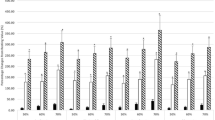Summary
Hard muscular work is accompanied by a leucocytosis in normal individuals and trained athletes, the leucocytosis in football players often showing an increase of between 200% and 300%. The magnitude of leucocytosis is related to both the duration and the intensity of work. Excitement alone will not cause a leucocytosis. Intense exertion of short duration produces a lymphocytosis which is followed by a polynuclear stage if the work is continued for a long enough time. The average recovery curve exhibits no appreciable drop in leucocyte count during the two hours following a football game unless the player lies down immediately after leaving the field. The absolute lymphocyte count falls rapidly for an hour or more after the player leaves the game. The rapidity of the leucocyte changes, the evidence against leucocytolysis and the absence of an appreciable increase in theSchilling-Torgau “band-form” cells all point toward a storage phenomenon. The bone marrow, spleen, liver, lungs, and organs of internal secretion must be considered as possible reservoirs, although no definite statement can yet be made as to the relative importance of each. The fact that lactic acid, blood sugar, blood pressure, body temperature, and capillary dilation can be ruled out as separate variables directly related to leucocytosis in exercise points toward a stimulus perhaps more complicated than has yet been studied. Any explanation of leucocytosis in exercise involving only a simple physical mechanism cannot at present be considered adequate.
Similar content being viewed by others
Bibliography
Schultz, Dtsch. Arch. klin. Med.11, 234 (1893).
Burrows, Amer. J. med. Sci.117, 503 (1899).
Zuntz andSchumberg, Studien zu einer Physiologie des Marsches. Berlin 1901.
Willebrand, Skand. Arch. Physiol. (Berl. u. Lpz.)14, 176 (1903).
Hawk, Amer. J. Physiol.10, 399 (1903/04).
Larrabee, J. med. Res., N. s.11, 76 (1902).
Larrabee, Tileston andEmerson, Boston med. J.148, 199 (1903).
Isaacs andGordon, Amer. J. Physiol.71, 106 (1924).
Jokl, Ernst, Arb.physiol.4, Nr 5, 379.
Weindrach, Fol. haemat. (Lpz.)38, 276 (1929).
Drinker, Drinker andKreutzmann, J. of exper. Med.27, 249 (1918).
Schneider andHavens, Amer. J. Physiol.36, 249 (1914/1915).
Schneider andHavens, Amer. J. Physiol.98, 352 (1931).
Mullins andLarge, J. amer. med. Assoc.97, Nr 16, 1133.
Selesnjew, Klin. Wschr.10, 456 (1931).
Benhamou andNouchy, J. Physiol. et Path. gén.29, Nr 1 (1931).
Sabin andDoan, Proc. Soc. exper. Biol. a. Med.25, 121 (1927).
Nye, Personal communication.
Jung andDeschamps, C. r. Soc. Biol. Paris1929, 1993.
Krogh, The Anatomy and Physiology of Capillaries.
Garrey, Proc. Staff Meetings Mayo Clinic4, 157 (1929).
Stitt, Practical Bacteriology, Blood Work, Parasitology.
, Amer. J. Physiol.98, 352 (1931).
Author information
Authors and Affiliations
Additional information
The authors are indebted toL. J. Henderson, D. B. Dill, andT. K. Richards for their cooperation and assistance in this work.
Rights and permissions
About this article
Cite this article
Edwards, H.T., Wood, W.B. A study of leukocytosis in exercise. Arbeitsphysiologie 6, 73–83 (1932). https://doi.org/10.1007/BF02009854
Received:
Issue Date:
DOI: https://doi.org/10.1007/BF02009854




